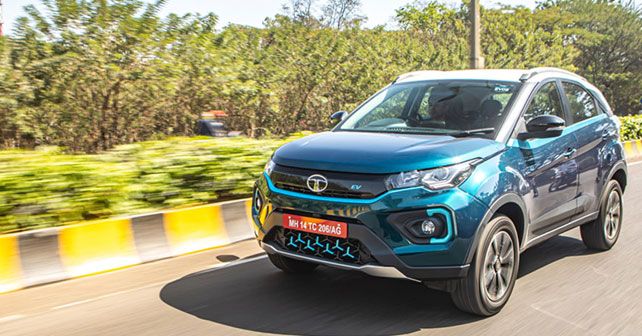
The Nexon Electric is the first truly usable electric car from an Indian manufacturer. But does it have what it takes to be a real pioneer in India?
I really love the enthusiasm with which Tata Motors approaches the market, for it does so with the noblest of intentions. Right from the days of the stylish Tata Sierra, which came way before its time, to the butch and luxurious (for its time) Safari, and from the highly successful Indica to the five-star NCAP-rated Nexon and Altroz, Tata Motors has always punched with all its might when it comes to offering more for your money – even if it sometimes ends up falling short in ironing out the small niggles.
So, in a typical Tata style, the home-grown carmaker has once again beaten everyone to the start line by bringing out the first truly usable Indian electric car – the all-electric Nexon. And, with it, Tata Motors aims to make modern electric cars more accessible to the majority of the car buying population – as the Nexon EV is expected to be priced in the ₹15 – 17 lakh range (ex-showroom). The market launch of the car isn’t too far away, and its prices will be out by the time you read this.
The first usable Indian electric car
Some may object to that claim, and point out that the Mahindra Reva was India’s first electric car – and that it was even exported to developed nations. But let’s be realistic here! The Reva’s operations were limited at best, given its extremely compact dimensions. And it certainly wasn’t capable of highway driving, without a fair amount range anxiety that is – not to mention its inability to achieve highway speeds to begin with!
This Nexon electric, on the other hand, certainly doesn’t shy away from any terrain that its ICE-powered sibling can conquer. And, like the standard model, it too has a very spacious cabin and a reasonably sized boot.
It’s well built, comes loaded with equipment, including connected car technology with a dual network connection, and also has a decent list of safety features. In short, the Nexon EV doesn’t fall short on any aspect of the modern automobile.
Tata Motors has even gone to the extent of ensuring that the floor of the car isn’t uncomfortably high – because of the battery pack underneath – as a result of which it doesn’t intrude into rear-seat legroom. What’s more, the car comes with an IP67-rated 30.2kWh lithium-ion polymer battery pack, which has a claimed maximum driving range of 312kms. And the power and torque figures of the car are rated at 127bhp and 245Nm, respectively. So, on the face of it, Tata seems to have all the bases covered.
In the real world…
Sure, all the on-paper figures for the Nexon Electric seem very adequate. But, as we all know, the real-world performance of a product is a different ballgame altogether, something that can’t be properly tested without spending some quality time with it. And that’s exactly what we managed to do, albeit only on a short drive – but one that involved varied terrain.
Our drive began from Pune. And, straightaway, I was impressed by the Nexon EV’s performance, as its powertrain offers a very linear driving experience, which makes it very easy to manoeuvre around town.
As expected, the car feels pretty refined as an EV. But, thankfully, the powertrain wasn’t completely devoid of feel – the electric motor emits a nice hum when the car is in motion. There’s also a healthy amount of NVH at city speeds, which keeps you aware of just what’s happening with the vehicle, as well as with your surroundings.
The only downside of the car, in terms of urban driving, is the lack of poke under sudden acceleration in D mode. You can overcome this by shifting to Sport (S) mode, which makes the Tata Nexon Electric’s performance quite sprightly. However, it’s a little bit too edgy to be driven in S all the time, especially in the city. In short, the gap between D and S driving modes is more than what it ought to be in my opinion.
On the expressway, you need to be in S mode to keep the momentum going. Here again, the Nexon impresses with more than adequate performance and admirable part-throttle response, which truly makes your drive electrifying.
However, the performance tends to taper off as you head past 100km/h, and the car seems unwilling to go past the 120km/h mark. That being said, in terms of real-world performance, I’d have to say that the Nexon EV offers just what you need.
Another thing that we did notice during the test drive was that, after a period of heavy throttle inputs, the powertrain developed a habit of juddering under acceleration – the more intense the acceleration, the more violent the judder. But lower the intensity of your inputs in D mode, and the judder becomes less prominent. While there’s no change in the performance, this is certainly something that needs looking into before the Nexon EV is offered for sale to the public.
I also don’t like the fact that there’s no Park mode for the transmission – it makes parking over steep inclines very risky, for the car remains stationary only because of the handbrake, which is connected to the drum brakes in the rear – and I’m not sure how reliable that would be in the long term, once your rear drums have worn out a little bit.
Worlds Apart
The Nexon Electric may appear identical to the standard ICE-powered version of the car, however, the suspension setup has undergone a lot of changes. Tata Motors states that this car now has 50:50 weight distribution between the front and the rear. Overall, the car does feel very-well balanced and it remains planted at even triple-digit speeds.
That said, despite the revised suspension setup, a changed spring and damper rate, and altered torsional rigidity of the chassis, the car’s handling still needs some fine-tuning. Around faster sweeping bends on uphill sections of road, the outside wheel offers adequate traction but the inside wheel struggles to maintain grip, as it doesn’t have enough weight pushing it down onto the road.
And when both wheels are in contact with the tarmac on an uphill bend, the sudden power delivery from the electric powertrain can cause a fair amount of understeer, as the tyres howl for grip even with part throttle inputs.
When you convert a conventional machine into an electric car, it’s practical to pack the lesser mechanicals into the former engine bay and put the battery in the floor of the chassis. But, because of the altered weight distribution, and the rather heavy battery spread across the floor, the dynamic capabilities of the chassis and suspension setup change drastically – and this makes a world of a difference in the way a car rides and handles.
And it’s for this reason that the Nexon Electric handles the way it does. In fact, because the suspension has had to be stiffened up to deal with the added weight, the ride too isn’t as comfortable as that of the standard Nexon – which is not to say that it’s bad, just that it isn’t as exemplarily as it is in the standard Nexon.
Focussed Approach
Now, everything that I’ve mentioned here is in the interest of giving you a comprehensive review of the car. But I’m afraid that some of it, concerning the vehicle’s dynamic capabilities, is a bit irrelevant. You see, as mentioned earlier, the Nexon Electric has been designed and built as a relatively affordable urban runabout. And, in that context, it’s very hard to fault it. In fact, it’s a great daily driver with a realistic driving range, which will likely take care of most people’s daily driving needs.
What’s more, Tata has really thought it through in terms of charging too. The car has AC charger compatibility, which means that it can be plugged into any 15 Amp household socket to be fully charged in about 8 hours. So, you don’t even need a three-phase electric connection to charge this car overnight!
But that’s not all! Tata has also cleverly provided a modern CCS Type 2 DC fast charging option, which allows the battery pack to be charged to 80% of its capacity in 60 minutes.
The Nexon EV, then, makes a strong case for itself as an emissions-free urban daily driver – it’s modern, both in its appearance and the way it drives, it comes generously equipped, is comfortable, and offers a spacious and practical cabin. So, it certainly is a complete car in the truest sense – but whether or not it pioneers an EV revolution in the country is something that remains to be seen.
- Tata Nexon Electric
Motor: Permanent magnet synchronous motor
Energy: Electricity
Battery: 30.2 kWh Lithium-ion Polymer
Transmission: Single-Speed / Front-Wheel Drive
Power: 127bhp
Torque: 245Nm
Operating temperature range: -5 to 45 degree Celsius
X-factor: A capable urban daily driver that meets all your needs.
| Pros • Comfortable to drive • Spacious cabin | Cons • Handling • No park mode for transmission |

More electric car reviews - Living with the Hyundai Kona Electric







![Tata Nexon EV [2020-2022] Tata Nexon EV [2020-2022] Model Image](https://static.autox.com/uploads/cars/2022/04/tata-nexon-ev.jpg)




















Write your Comment